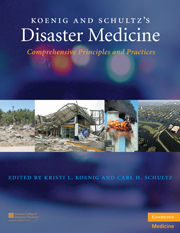Book contents
- Frontmatter
- Contents
- List of Contributors
- Contributor Biographies
- Foreword
- Preface
- Acknowledgments
- PART I CONCEPTUAL FRAMEWORK AND STRATEGIC OVERVIEW
- 1 Disaster Research and Epidemiology
- 2 Disaster Education and Training: Linking Individual and Organizational Learning and Performance
- 3 Surge Capacity
- 4 International Perspectives on Disaster Management
- 5 Ethical Issues in Disaster Medicine
- 6 Emerging Infectious Diseases: Concepts in Preparing for and Responding to the Next Microbial Threat
- 7 Disaster Mental and Behavioral Health
- 8 Special Needs Populations
- PART II OPERATIONAL ISSUES
- PART III CLINICAL MANAGEMENT
- Index
- Plate section
- References
1 - Disaster Research and Epidemiology
from PART I - CONCEPTUAL FRAMEWORK AND STRATEGIC OVERVIEW
Published online by Cambridge University Press: 05 August 2011
- Frontmatter
- Contents
- List of Contributors
- Contributor Biographies
- Foreword
- Preface
- Acknowledgments
- PART I CONCEPTUAL FRAMEWORK AND STRATEGIC OVERVIEW
- 1 Disaster Research and Epidemiology
- 2 Disaster Education and Training: Linking Individual and Organizational Learning and Performance
- 3 Surge Capacity
- 4 International Perspectives on Disaster Management
- 5 Ethical Issues in Disaster Medicine
- 6 Emerging Infectious Diseases: Concepts in Preparing for and Responding to the Next Microbial Threat
- 7 Disaster Mental and Behavioral Health
- 8 Special Needs Populations
- PART II OPERATIONAL ISSUES
- PART III CLINICAL MANAGEMENT
- Index
- Plate section
- References
Summary
OVERVIEW
Defining Disaster
There is no single, agreed-upon definition of disaster either within or across disciplines. Definitions used in practice and research vary widely, reflecting differing objectives and interests in regard to the causes, consequences, and processes involved in disasters. In the Preface, Koenig presents a terminology for describing disasters that focuses on the functional impact of disasters to the healthcare system. This chapter discusses research methods and findings in the context of the broader spectrum of processes involved in disasters including, but not limited to, the impact on the healthcare system, the short- and long-term effects on people's health and livelihoods, and the behaviors of individuals, groups, and organizations in relation to disasters.
Accordingly, a disaster is “any community emergency that seriously affects people's lives and property and exceeds the capacity of the community to respond effectively to the emergency.” For instance, Hurricane Katrina was a category 5 hurricane at its peak, which made landfall as a category 3 hurricane in the Gulf Coast region of the United States on August 29, 2005. Its accompanying storm surge overwhelmed the local flood protection system, flooded entire communities, led to mass evacuation, caused multiple human casualties, and significantly disrupted people's livelihoods. It overwhelmed the response capacity of the community at the individual, household, and organizational levels. Thus, studies of this disaster legitimately go beyond its impact on the healthcare system.
Keywords
- Type
- Chapter
- Information
- Koenig and Schultz's Disaster MedicineComprehensive Principles and Practices, pp. 3 - 20Publisher: Cambridge University PressPrint publication year: 2009
References
- 1
- Cited by



